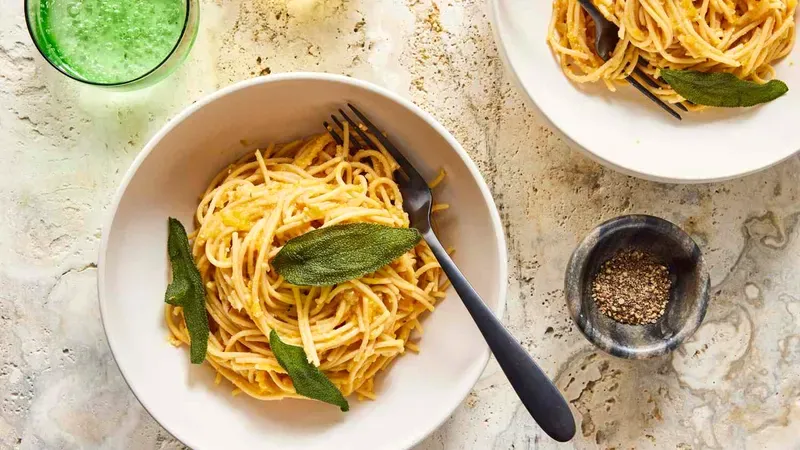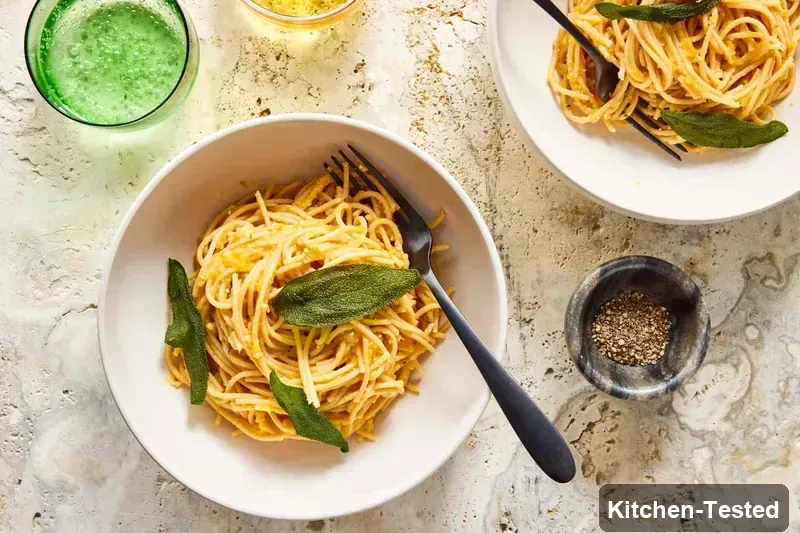Creamy Butternut Squash Pasta (No Cream Needed!)
This cozy butternut squash pasta will make your whole family smile on chilly nights! It’s naturally creamy and packed with fall flavors that both kids and adults absolutely love. Plus, you get all that amazing nutrition from butternut squash without any heavy cream.

Recipe Details
Timing & Servings: Active Time: 30 minutes, Total Time: 30 minutes, Serves: 4 people.
Nutrition Profile: Sesame-Free, Nut-Free, High-Fiber, Vegetarian, Egg-Free.
Nutrition Facts (per serving): 367 Calories, 14g Fat, 55g Carbs, 11g Protein.
Ingredients You’ll Need
Grapeseed oil: You’ll need 3 tablespoons of grapeseed oil or any neutral oil you have. This creates the perfect base for frying our sage leaves until they’re crispy and golden.
Fresh sage leaves: Grab 12 large fresh sage leaves for that amazing earthy flavor. These get fried until crispy and make the most beautiful garnish too!
Butternut squash: You’ll need 2 cups of cubed, peeled butternut squash. This is your star ingredient that creates the creamy, naturally sweet sauce.
Shallot: One large shallot chopped up gives you about 1/2 cup. Shallots are milder than onions and add such a lovely flavor to the dish.
Garlic: Three medium cloves smashed up will fill your kitchen with the most amazing smell. Don’t worry about perfect chopping – smashed works great here!
Fresh thyme: Just 1 teaspoon of chopped fresh thyme adds that perfect herby touch. It pairs beautifully with the butternut squash.
Salt: Half a teaspoon of salt helps bring out all those wonderful flavors. You can always adjust to taste later.
Vegetable broth: You’ll need 3/4 cup of lower-sodium vegetable broth to help cook the squash until it’s perfectly tender.
White miso: This might be new to you, but 1 1/2 teaspoons of white miso adds incredible depth and umami flavor. It’s the secret to making this taste so rich!
Whole-wheat spaghetti: Eight ounces of whole-wheat spaghetti gives you all that fiber and nutrition. Regular spaghetti works too if that’s what you have.
Parmesan cheese: Three tablespoons of grated Parmesan cheese makes everything creamy and adds that perfect finishing touch.
How to Make Butternut Squash Pasta

Step 1: Heat your oil in a large skillet over medium-high heat until it’s shimmering. Add 6 sage leaves and cook them, flipping once, until they’re crispy – about 30 seconds to 1 minute. Move them to a paper-towel-lined plate. Repeat with the other 6 sage leaves. Don’t clean the pan – those flavored drippings are gold!
Step 2: Add your cubed squash to those yummy drippings in the pan. Cook over medium-high heat, stirring every few minutes, until the squash is soft and has some lovely charred spots – about 10 to 12 minutes. Add the shallot, garlic, thyme, and salt. Cook everything together, stirring often, until it smells amazing and everything is soft – about 3 minutes.
Step 3: Add the broth and miso to your squash mixture. Keep cooking and stirring often until the squash is super tender – about 4 minutes. Meanwhile, get a large pot of water boiling over high heat. Add your pasta and cook it just like the package says until it’s al dente. Before you drain it, save 1 cup of that starchy pasta water – you’ll need it!
Step 4: Here’s the magic part! Put your squash mixture into a blender. Make sure the lid is on tight, but remove the center piece so steam can escape. Put a clean towel over the opening. Blend until it’s super smooth – about 1 minute.
Step 5: Put your drained pasta and that beautiful squash sauce back in the pasta pot. Stir in 1/2 cup of your saved pasta water. Cook over medium heat, stirring often and adding more pasta water 1/4 cup at a time until the sauce is creamy and clings to the pasta – about 3 minutes. Add the Parmesan, stirring constantly until it’s melted and smooth – about 1 minute. Serve in shallow bowls and top with those crispy sage leaves!
Easy and Quick Butternut Squash Pasta Version
Want to make this even faster? You can totally use pre-cut butternut squash from the store! Also, if you’re short on time, skip the crispy sage leaves and just add 1/2 teaspoon of dried sage right to the squash mixture. It’ll still taste amazing and save you about 5 minutes!
Serving Ideas
This pasta is pretty much a complete meal all by itself! But if you want to add something extra, try a simple green salad with lemon vinaigrette. A crusty piece of garlic bread is also perfect for soaking up any extra sauce. For special occasions, add some toasted pine nuts or pumpkin seeds on top for extra crunch!
Storage
Store any leftovers in the fridge for up to 3 days in a covered container. To reheat, add a splash of vegetable broth or water to a pan and warm it over medium heat, stirring gently. You can also microwave it for 1-2 minutes, stirring halfway through. The sauce might thicken up, so don’t be afraid to add a little more broth to loosen it up!
Substitutions
No white miso? You can use regular miso paste, but start with just 1/2 teaspoon since it’s stronger. Don’t have fresh thyme? Use 1/4 teaspoon dried thyme instead. Regular spaghetti works great if you don’t have whole wheat. You can even try this with penne or rigatoni – the sauce will cling to those shapes beautifully too!
Pro Tips
- Don’t skip the pasta water: That starchy water is what makes the sauce silky and helps it stick to the pasta perfectly.
- Char the squash: Those slightly burnt edges add so much flavor – don’t stir too often!
- Blend while hot: The squash blends much smoother when it’s still warm from cooking.
- Save some sage: Those crispy sage leaves make all the difference – they’re like little flavor bombs!
- Taste as you go: Add more salt or Parmesan if you think it needs it – trust your taste buds!
FAQs
Is butternut squash really that nutritious?
You bet! Butternut squash is amazing for you. In just 1 cup, you get a whopping 400% of your daily vitamin A and 3 grams of fiber. It’s also packed with vitamin C, B vitamins, potassium, and magnesium. Plus, it has zeaxanthin, which is great for your eyes, heart, and immune system!
Is this recipe actually vegetarian?
Yes! Just make sure your Parmesan cheese doesn’t have rennet in it – that’s an animal-derived ingredient. Look for cheese that says “vegetarian-friendly” on the package, like Organic Valley’s Parmesan.
Can I use regular pasta instead of whole wheat?
Sure! Regular spaghetti works perfectly fine. Whole wheat just gives you extra fiber and nutrients, but use whatever makes you happy. If you’re not sure about whole wheat, try using half whole wheat and half regular – it’s a great compromise!
What if I don’t have fresh thyme?
No worries! Use 1/4 to 1/2 teaspoon of dried thyme instead. It won’t be quite as bright, but it’ll still taste delicious.
What exactly is white miso and can I substitute it?
White miso is a mild, sweet fermented soybean paste that adds incredible umami flavor. If you can only find red or other types of miso, just use 1/2 to 1 teaspoon instead since they’re stronger. Trust me, the miso makes this dish so much richer!
Why do I need to save the pasta water?
That starchy pasta water is pure magic! It helps thicken the sauce and makes it cling to the pasta beautifully. Without it, your sauce might be too thin or won’t stick to the noodles properly.
What should I serve with this pasta?
This pasta is pretty complete on its own, but a simple salad is always nice! Try it with a kale salad with cranberries or a crunchy red cabbage salad. Even just some garlic bread on the side makes it feel extra special!
I hope you love this cozy pasta as much as my family does! Let me know in the comments how yours turned out – I love hearing about your cooking adventures. Did you try any fun variations? I’m always excited to hear your creative twists on recipes!